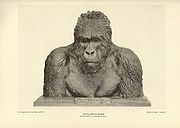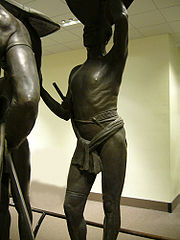
Carl Akeley
Encyclopedia

Sculpture
Sculpture is three-dimensional artwork created by shaping or combining hard materials—typically stone such as marble—or metal, glass, or wood. Softer materials can also be used, such as clay, textiles, plastics, polymers and softer metals...
, biologist
Biologist
A biologist is a scientist devoted to and producing results in biology through the study of life. Typically biologists study organisms and their relationship to their environment. Biologists involved in basic research attempt to discover underlying mechanisms that govern how organisms work...
, conservationist
Conservationist
Conservationists are proponents or advocates of conservation. They advocate for the protection of all the species in an ecosystem with a strong focus on the natural environment...
, inventor, and nature photographer, noted for his contributions to American museums, most notably to the Field Museum of Natural History
Field Museum of Natural History
The Field Museum of Natural History is located in Chicago, Illinois, USA. It sits on Lake Shore Drive next to Lake Michigan, part of a scenic complex known as the Museum Campus Chicago...
and the American Museum of Natural History
American Museum of Natural History
The American Museum of Natural History , located on the Upper West Side of Manhattan in New York City, United States, is one of the largest and most celebrated museums in the world...
. He is considered the father of modern taxidermy
Taxidermy
Taxidermy is the act of mounting or reproducing dead animals for display or for other sources of study. Taxidermy can be done on all vertebrate species of animals, including mammals, birds, fish, reptiles, and amphibians...
.
He was born in Clarendon, New York
Clarendon, New York
Clarendon is a town in Orleans County, New York, United States. The population was 3,392 at the 2000 census. The name is derived from Clarendon, Vermont.The Town of Clarendon is in the southeast part of the county...
, and grew up on a farm, attending school for only three years. He learned taxidermy
Taxidermy
Taxidermy is the act of mounting or reproducing dead animals for display or for other sources of study. Taxidermy can be done on all vertebrate species of animals, including mammals, birds, fish, reptiles, and amphibians...
from David Bruce in Brockport, New York
Brockport, New York
Brockport is a village located in the Town of Sweden in Monroe County, New York, USA. The population was 8,103 at the 2000 census. The name is derived from Hiel Brockway, an early settler....
, and then entered an apprenticeship in taxidermy at Ward's Natural Science Establishment
Henry Augustus Ward
Henry Augustus Ward was an American naturalist and geologist, born in Rochester, New York.After attending Williams College and the Lawrence Scientific School, Harvard, where he was an assistant of Louis Agassiz, he traveled in Egypt, Arabia, and Palestine, and studied at the Jardin des Plantes,...
in Rochester, New York
Rochester, New York
Rochester is a city in Monroe County, New York, south of Lake Ontario in the United States. Known as The World's Image Centre, it was also once known as The Flour City, and more recently as The Flower City...
. In 1886 Akeley moved on to the Milwaukee Public Museum
Milwaukee Public Museum
The Milwaukee Public Museum is a natural and human history museum located in downtown Milwaukee, Wisconsin, USA. The museum was chartered in 1882 and opened to the public in 1884; it is a not-for-profit organization operated by the Milwaukee Public Museum, Inc. MPM has three floors of exhibits...
(MPM) in Milwaukee, Wisconsin
Milwaukee, Wisconsin
Milwaukee is the largest city in the U.S. state of Wisconsin, the 28th most populous city in the United States and 39th most populous region in the United States. It is the county seat of Milwaukee County and is located on the southwestern shore of Lake Michigan. According to 2010 census data, the...
, where he created the world's first complete museum habitat diorama in 1890. Akeley remained in Milwaukee for eight years, refining "model" techniques used in taxidermy. At the Milwaukee Public Museum
Milwaukee Public Museum
The Milwaukee Public Museum is a natural and human history museum located in downtown Milwaukee, Wisconsin, USA. The museum was chartered in 1882 and opened to the public in 1884; it is a not-for-profit organization operated by the Milwaukee Public Museum, Inc. MPM has three floors of exhibits...
, his early work consisted of animals found in Wisconsin
Wisconsin
Wisconsin is a U.S. state located in the north-central United States and is part of the Midwest. It is bordered by Minnesota to the west, Iowa to the southwest, Illinois to the south, Lake Michigan to the east, Michigan to the northeast, and Lake Superior to the north. Wisconsin's capital is...
praries and woodlands. In addition, he also created historical reindeer and orangutan exhibits. While working at the Milwaukee Public Museum
Milwaukee Public Museum
The Milwaukee Public Museum is a natural and human history museum located in downtown Milwaukee, Wisconsin, USA. The museum was chartered in 1882 and opened to the public in 1884; it is a not-for-profit organization operated by the Milwaukee Public Museum, Inc. MPM has three floors of exhibits...
and later, at the Field Museum of Natural History
Field Museum of Natural History
The Field Museum of Natural History is located in Chicago, Illinois, USA. It sits on Lake Shore Drive next to Lake Michigan, part of a scenic complex known as the Museum Campus Chicago...
in Chicago
Chicago
Chicago is the largest city in the US state of Illinois. With nearly 2.7 million residents, it is the most populous city in the Midwestern United States and the third most populous in the US, after New York City and Los Angeles...
, he developed his innovative taxidermy techniques perfecting a "cement gun" for improving exhibits. He later applied this method to patch old buildings with concrete, and is today known as the inventor of shotcrete
Shotcrete
Shotcrete is concrete conveyed through a hose and pneumatically projected at high velocity onto a surface, as a construction technique....
.
Akeley specialized in African mammals, particularly the gorilla
Gorilla
Gorillas are the largest extant species of primates. They are ground-dwelling, predominantly herbivorous apes that inhabit the forests of central Africa. Gorillas are divided into two species and either four or five subspecies...
and the elephant
Elephant
Elephants are large land mammals in two extant genera of the family Elephantidae: Elephas and Loxodonta, with the third genus Mammuthus extinct...
. As a taxidermist, he improved on techniques of fitting the skin over a carefully prepared and sculpted form of the animal's body, producing very lifelike specimens, with consideration of musculature, wrinkles, and veins. He also displayed the specimens in groups in a natural setting. Many animals that he preserved he had personally collected.
In 1909 Akeley accompanied Theodore Roosevelt
Theodore Roosevelt
Theodore "Teddy" Roosevelt was the 26th President of the United States . He is noted for his exuberant personality, range of interests and achievements, and his leadership of the Progressive Movement, as well as his "cowboy" persona and robust masculinity...
on an expedition to Africa
Africa
Africa is the world's second largest and second most populous continent, after Asia. At about 30.2 million km² including adjacent islands, it covers 6% of the Earth's total surface area and 20.4% of the total land area...
and began working at the American Museum of Natural History
American Museum of Natural History
The American Museum of Natural History , located on the Upper West Side of Manhattan in New York City, United States, is one of the largest and most celebrated museums in the world...
in New York City
New York City
New York is the most populous city in the United States and the center of the New York Metropolitan Area, one of the most populous metropolitan areas in the world. New York exerts a significant impact upon global commerce, finance, media, art, fashion, research, technology, education, and...
, where his efforts can still be seen in the Akeley African Hall. Akeley joined the Explorers Club
The Explorers Club
The Explorers Club is a professional society dedicated to scientific exploration of Earth, its oceans, and outer space. Founded in 1904 in New York City, it currently has 30 branches world wide...
in 1912, having been sponsored by three of the Club's seven Charter Members: Frank Chapman, Henry Collins Walsh, and Marshall Saville. For qualifying, Akeley wrote only, "Explorations in Somaliland and British East Africa." He became the Club's sixth president in 1917–1918.
In 1921, eager to learn about gorilla
Gorilla
Gorillas are the largest extant species of primates. They are ground-dwelling, predominantly herbivorous apes that inhabit the forests of central Africa. Gorillas are divided into two species and either four or five subspecies...
s to determine if killing them for museum dioramas was justified, Akeley led an expedition to Mt. Mikeno in the Virungas at the edge of the then Belgian Congo
Belgian Congo
The Belgian Congo was the formal title of present-day Democratic Republic of the Congo between King Leopold II's formal relinquishment of his personal control over the state to Belgium on 15 November 1908, and Congolese independence on 30 June 1960.-Congo Free State, 1884–1908:Until the latter...
. At that time, gorillas were quite exotic, with very few even in zoos, and collecting such animals for educational museum exhibitions was not uncommon. In the process of “collecting” several mountain gorilla
Mountain Gorilla
The Mountain Gorilla is one of the two subspecies of the Eastern Gorilla. There are two populations. One is found in the Virunga volcanic mountains of Central Africa, within three National Parks: Mgahinga, in south-west Uganda; Volcanoes, in north-west Rwanda; and Virunga in the eastern Democratic...
s, Akeley’s attitude was fundamentally changed and for the remainder of his life he worked for the establishment of a gorilla preserve in the Virungas. In 1925, greatly influenced by Akeley, King Albert I of Belgium established the Albert National Park, (since renamed Virunga National Park
Virunga National Park
The Virunga National Park , formerly named Albert National Park, is a 7800 square km National Park that stretches from the Virunga Mountains in the South, to the Rwenzori Mountains in the North, in the eastern Democratic Republic of Congo, bordering Volcanoes National Park in Rwanda and Rwenzori...
). It was Africa's first national park. Opposed to hunting them for sport or trophies, he remained an advocate of collection for scientific and educational purposes. One of the members of his 1921 expedition was six-year-old Alice Hastings Bradley, who later wrote science fiction under the name James Tiptree, Jr..
He improved the motion picture camera
Camera
A camera is a device that records and stores images. These images may be still photographs or moving images such as videos or movies. The term camera comes from the camera obscura , an early mechanism for projecting images...
for working in nature. Akeley also wrote several books, including stories for children, and an autobiography In Brightest Africa (1920). He was awarded more than thirty patent
Patent
A patent is a form of intellectual property. It consists of a set of exclusive rights granted by a sovereign state to an inventor or their assignee for a limited period of time in exchange for the public disclosure of an invention....
s for his inventions.
Akeley died of a fever in the Congo
Belgian Congo
The Belgian Congo was the formal title of present-day Democratic Republic of the Congo between King Leopold II's formal relinquishment of his personal control over the state to Belgium on 15 November 1908, and Congolese independence on 30 June 1960.-Congo Free State, 1884–1908:Until the latter...
during his fifth expedition to Africa. He is buried in Africa, just miles from where he encountered his first gorilla, the “Old Man of Mikeno.”
His wife, Mary Jobe Akeley
Mary Jobe Akeley
Mary Jobe Akeley was an explorer and naturalist and the wife of Carl E. Akeley. She is famous as one of the earliest women explorers in Africa where she helped her husband hunt and photograph animals during their natural history studies...
, married him two years before he died. He had previously been married to Delia J. Akeley
Delia Akeley
Delia Julia Akeley , commonly known by her nickname, Mickie, was an American explorer. She was born in Beaver Dam, Wisconsin, a daughter of Patrick and Margaret Denning, Irish immigrants....
(1875–1970) for nearly twenty years. Delia Akeley accompanied him on two of his biggest and most productive safaris to Africa in 1905 and again in 1909. Delia later returned to Africa twice under the auspices of the Brooklyn Museum of Arts and Sciences. She organized and led both trips and lived for several months in the Ituri Forest with Pygmies.
The World Taxidermy & Fish Carving Championships awards gold medallions that bear Carl Akeley’s likeness—based on a photograph he had taken at Stein Photography in Milwaukee—to its “Best in World” winners. There is also a Carl Akeley Award for the most artistic mount at the World Show. The medallions were sculpted by Floyd Easterman of the Milwaukee Public Museum. The Akeley Hall of African Mammals of the American Museum of Natural History
American Museum of Natural History
The American Museum of Natural History , located on the Upper West Side of Manhattan in New York City, United States, is one of the largest and most celebrated museums in the world...
is named for him.

Further reading
- Akeley, Carl. In Brightest Africa, Garden City Publishers, 1920.
- Akeley, Delia J.Delia AkeleyDelia Julia Akeley , commonly known by her nickname, Mickie, was an American explorer. She was born in Beaver Dam, Wisconsin, a daughter of Patrick and Margaret Denning, Irish immigrants....
Jungle Portraits, Macmillan, 1930. - Akeley, Mary JobeMary Jobe AkeleyMary Jobe Akeley was an explorer and naturalist and the wife of Carl E. Akeley. She is famous as one of the earliest women explorers in Africa where she helped her husband hunt and photograph animals during their natural history studies...
. Carl Akeley's Africa: The account of the Akeley-Eastman-Pomeroy African Hall Expedition of the American Museum of Natural History, Dodd, Mead, 1929. - Akeley, Mary JobeMary Jobe AkeleyMary Jobe Akeley was an explorer and naturalist and the wife of Carl E. Akeley. She is famous as one of the earliest women explorers in Africa where she helped her husband hunt and photograph animals during their natural history studies...
. The Wilderness Lives Again: Carl Akeley and the Great Adventure, Dodd, Mead, 1940 - Bodry-Sanders, Penelope. Carl Akeley: Africa's Collector, Africa's Savior, Paragon House, 1991.
- Bodry-Sanders, Penelope. African Obsession, The Life and Legacy of Carl Akeley (2nd ed.), Jacksonville, FL:Batax Museum Publishing, 1998. ISBN 0962975990
- Chapman, Roy. Beyond Adventure: The Lives of Three Explorers, Duell, Sloan and Pearce, 1954.
- Kirk, Jay. Kingdom Under Glass, Henry Holt and CompanyHenry Holt and CompanyHenry Holt and Company is an American book publishing company. One of the oldest publishers in the United States, it was founded in 1866 by Henry Holt and Frederick Leypoldt...
, 2010. ISBN 978-0-8050-9282-0. - (video) "Kingdom Under Glass", Jay Kirk, C-SpanC-SPANC-SPAN , an acronym for Cable-Satellite Public Affairs Network, is an American cable television network that offers coverage of federal government proceedings and other public affairs programming via its three television channels , one radio station and a group of websites that provide streaming...
, October 27, 2010.
External links
- http://www.archive.org/search.php?query=mediatype%3A(texts)%20-contributor%3Agutenberg%20AND%20(subject%3A%22Akeley%2C%20Carl%20Ethan%2C%201864-1926%22%20OR%20subject%3A%22Akeley%2C%20C%2E%20E%2E%20%28Carl%20Ethan%29%2C%201864-1926%22%20OR%20subject%3A%22Akeley%2C%20Carl%20E%2E%20%28Carl%20Ethan%29%2C%201864-1926%22%20OR%20subject%3A%22Akeley%2C%20Carl%20Ethan%22%20OR%20subject%3A%22Akeley%2C%20C%2E%20E%2E%20%28Carl%20Ethan%29%22%20OR%20subject%3A%22Akeley%2C%20Carl%20E%2E%20%28Carl%20Ethan%29%22%20OR%20subject%3A%22Carl%20Ethan%20Akeley%22%20OR%20subject%3A%22Carl%20E%2E%20Akeley%22%20OR%20subject%3A%22C%2E%20E%2E%20Akeley%22%20OR%20creator%3A%22Akeley%2C%20Carl%20Ethan%2C%201864-1926%22%20OR%20creator%3A%22Akeley%2C%20Carl%20Ethan%2C%20Sir%2C%201864-1926%22%20OR%20creator%3A%22Akeley%2C%20C%2E%20E%2E%20%28Carl%20Ethan%29%2C%201864-1926%22%20OR%20creator%3A%22Akeley%2C%20Carl%20E%2E%20%28Carl%20Ethan%29%2C%201864-1926%22%20OR%20creator%3A%22Akeley%2C%20Carl%20Ethan%22%20OR%20creator%3A%22Akeley%2C%20C%2E%20E%2E%20%28Carl%20Ethan%29%22%20OR%20creator%3A%22Akeley%2C%20Carl%20E%2E%20%28Carl%20Ethan%29%22%20OR%20creator%3A%22Carl%20Ethan%20Akeley%22%20OR%20creator%3A%22Carl%20E%2E%20Akeley%22%20OR%20creator%3A%22C%2E%20E%2E%20Akeley%22%20OR%20title%3A%22Carl%20Ethan%20Akeley%22%20OR%20title%3A%22Carl%20E%2E%20Akeley%22%20OR%20title%3A%22C%2E%20E%2E%20Akeley%22%20OR%20description%3A%22Carl%20Ethan%20Akeley%22%20OR%20description%3A%22Carl%20E%2E%20Akeley%22%20OR%20description%3A%22C%2E%20E%2E%20Akeley%22%20OR%20description%3A%22Akeley%2C%20Carl%20Ethan%22%20OR%20description%3A%22Akeley%2C%20C%2E%20E%2E%20%28Carl%20Ethan%29%22%20OR%20description%3A%22Akeley%2C%20Carl%20E%2E%20%28Carl%20Ethan%29%22)Works by or about Carl Ethan Akeley] at Internet ArchiveInternet ArchiveThe Internet Archive is a non-profit digital library with the stated mission of "universal access to all knowledge". It offers permanent storage and access to collections of digitized materials, including websites, music, moving images, and nearly 3 million public domain books. The Internet Archive...
(scanned books original editions color illustrated)

